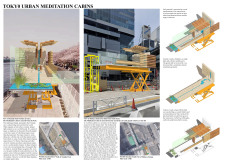5 key facts about this project
The Tokyo Urban Meditation Cabins explore the connection between urban life and nature. Located near busy spots like the River Walk at Sumida Park and Shibuya Station, the cabins provide a quiet place for people to step away from the hustle and bustle of daily life. The design focuses on creating a space for reflection and mindfulness, balancing the demands of the city with the serenity of the natural world.
Concept and Spatial Arrangement
The design emphasizes a unique spatial experience through careful elevation. The cabins are raised, allowing visitors to experience the sounds and sights of the city while maintaining a sense of peace. This elevation offers a way to engage with the vibrant surroundings without feeling overwhelmed. Users can find solitude while remaining aware of their urban context.
Natural Light and Transparency
Natural light is a key feature of the cabin design. Large openings allow sunlight to fill the interior spaces, creating a warm atmosphere that connects the inside with the outside. The openness of the design helps bridge the gap between the built environment and nature, inviting users to enjoy the changing light throughout the day. This design choice enhances the overall experience, making the cabins feel larger and more integrated with their surroundings.
Materiality and Ecological Context
Materials used in the cabins reflect the goal of blending with the local environment. Granite appears in various forms, such as boulders and rough slabs, providing a natural aesthetic that resonates with the landscape. The use of cypress, in forms like logs and plywood, adds warmth and texture, creating an inviting atmosphere. Water reeds, used for thatching, grow in the designed watercourses, reinforcing the connection between the buildings and the natural world. The careful selection of materials supports the intention of fostering a peaceful environment.
Enhanced User Experience
The combination of elevation, natural light, and thoughtful materials results in a welcoming space that encourages meditation and reflection. By offering a retreat from urban stress, the cabins invite individuals to reconnect with themselves and their surroundings. Each design element works together to create a cohesive environment, where visitors can enjoy the tranquility of nature while still being aware of the vibrant city life just beyond. The overall experience captures a balance between quiet reflection and urban engagement.




















































